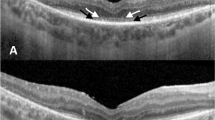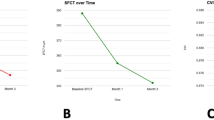Abstract
Purpose
To study the effect of orbital tumors on visual functions and highlight the factors predictive of visual outcome after surgery.
Methods
A prospective interventional study compared visual function parameters and fundus changes, before and after surgery, in eyes having well-defined orbital tumors with the normal fellow eye. These included visual acuity (VA), refractive error, keratometry changes, color vision, Goldmann visual field (GVF), and visual evoked response (VER).
Results
In total 28 cases (age range 7–56 years), of which the majority of tumors were vascular (46%) and lacrimal (18%) in origin, had a mean VA of 0.54±0.33 in the affected eye, which improved postoperatively to 0.66±0.31 (P=0.002). The affected eye had a median refractive error of +0.00 DS (−2.00 to 5.13), which was significantly more hyperopic than the normal eye (median +0.00 DS; range −1.25 to +1.63 DS) and normalized postoperatively. Keratometry showed higher astigmatism in the involved eye (P=0.004). The fundus showed disc pallor, edema, and/or choroidal folds, of which disc edema resolved in all cases after surgery. In all, 40% of the affected eyes had a deficient color vision and this partially improved postoperatively (P=0.25). GVF had abnormalities in 10 cases, half of which normalized postoperatively (P=0.04). The VER of affected eyes had a mean amplitude of 8.91±4.59 μv and latency of 116.3±14.7 ms, with improvement after surgery (P=0.005 and 0.001, respectively).
Conclusion
Orbital tumors adversely affected visual functions. The presenting acuity depended on disc changes, color vision abnormalities, and prolonged VER latency. The postoperative VA depended on VA at presentation, amount of proptosis, degree of hyperopia, and clinically significant VER abnormalities.
Similar content being viewed by others
Log in or create a free account to read this content
Gain free access to this article, as well as selected content from this journal and more on nature.com
or
References
Sunderraj P . Malignant tumours of the eye and adnexa. Indian J Ophthalmol 1991; 39: 6–8.
Gogi R, Nath K, Ahuja L, Shukla M . Ocular and adnexal tumours. Indian J Ophthalmol 1979; 27: 25–28.
Friberg TR, Grove AS . Choroidal folds and refractive errors associated with orbital tumors. Arch Ophthalmol 1983; 101: 589–603.
Dubois J, Milot J, Jaeger BI, McCuaig C, Rousseau E, Powell J . Orbital and eyelid hemangiomas: is there a relationship between location and ocular problems? J Am Acad Dermatol 2006; 55: 614.
Sharma V, Betharia SM . Prospective evaluation of fundus changes in patients with orbital mass lesions. Retina 2006; 26: 415–421.
Wei R, L Y, Zhou Y . Automated perimetry analysis of optic nerve compression caused by orbital tumors and tumor-like lesions. 1997; 33: 33–35.
Brecelj J, Stirn-Kranjc B, Skrbec M . Visual electrophysiology in children with tumours affecting the visual pathway: Case reports. Doc Ophthalmol 2000; 101: 125–154.
Oken BS, Chiappa KH, Gill E . Normal temporal variability of the P100. Electroencephalogr Clin Neurophysiol 1987; 68: 153–156.
Nath K, Gogi R . Primary orbital tumours. Indian J Ophthalmol 1977; 25: 10–16.
Ohtsuka K, Hashimoto M, Suzuki Y . Review of 244 orbital tumors in Japanese patients during a 21 year period: origin and locations. Jpn J Ophthalmol 2005; 49: 49–55.
Shields JA, Shields CL, Scartozzi R . Survey of 1264 patients with orbital tumors and simulating lesions: The 2002 Montgomery Lecture, part 1. Ophthalmology 2004; 111: 997–1008.
Bajaj MS, Pushker N, Chaturvedi A, Betharia SM, Kashyap S, Balasubramanya R et al. Orbital space-occupying lesions in Indian children. J Pediatr Ophthalmol Strabismus 2007; 44: 106–111.
Viswanathan S, George S, Ramadwar M, Shet T, Arora B, Laskar S et al. Extraconal orbital tumors in children—A spectrum. Virchows Arch 2009; 454: 703–713.
Masud MZ, Babar TF, Iqbal A, Khan MT, Zaffar ul Islam, Khan MD . Proptosis: etiology and demographic patterns. J Coll Physicians Surg Park 2006; 16: 38–41.
Ben Simon GJ, Yoon MK, Atul J, Nakra T, McCann JD, Goldberg RA . Clinical manifestations of orbital mass lesions at the Jules Stein Eye Institute. 1999–2003. Ophthalmic Surg Lasers Imaging 2006; 37: 25–32.
Sulimma F, Lieb WE . Orbital surgery: perioperative problems and results problems and results. Ophthalmologe 1999; 96: 724–727.
Park HJ, Yang SH, Kim IS, Sung JH, Son BC, Lee SW . Surgical treatment of orbital tumors at a single institution. J Korean Neurosurg Soc 2008; 44: 146–150.
Robb RM . Refractive errors associated with hemangiomas of the eyelids and orbit in infancy. Am J Ophthalmol 1977; 83: 52–58.
Wu J, Lai TF, Leibovitch I, Selva D . Persistent posterior globe flattening after orbital cavernous haemangioma excision. Clin Experiment Ophthalmol 2005; 33: 424–425.
Chandrasekaran S, Petsoglou C, Billson FA, Selva D, Ghabrial R . Refractive change in thyroid eye disease (a neglected clinical sign). Br J Ophthalmol 2006; 90: 307–309.
Sagili S, DeSousa JL, Malhotra R . Intraocular pressure and refractive changes following orbital decompression with intraconal fat excision. Open Ophthalmol J 2008; 2: 73–76.
Cockerham KP, Cockerham GC, Stutzman R, Hidayat AA, Depper MH, Turbin RE et al. The clinical spectrum of schwannomas presenting with visual dysfunction: a clinicopathologic study of three cases. Surv Ophthalmol 1999; 44: 226–234.
Janáky M, Benedek G . Visual evoked potentials during the early phase of optic nerve compression in the orbital cavity. Doc Ophthalmol 1992; 81: 197–208.
Author information
Authors and Affiliations
Corresponding author
Ethics declarations
Competing interests
The authors declare no conflict of interest.
Rights and permissions
About this article
Cite this article
Singh, D., Pushker, N., Bajaj, M. et al. Visual function alterations in orbital tumors and factors predicting visual outcome after surgery. Eye 26, 448–453 (2012). https://doi.org/10.1038/eye.2011.308
Received:
Accepted:
Published:
Issue date:
DOI: https://doi.org/10.1038/eye.2011.308
Keywords
This article is cited by
-
Stereotactic radiosurgery for orbital cavernous venous malformation: a single center’s experience for 15 years
Acta Neurochirurgica (2021)
-
Post-operative optical coherence tomography angiography features of chorioretinal folds resulting from pleomorphic adenoma of the lacrimal gland (PALG) of orbit- a case report
BMC Ophthalmology (2020)
-
Biometric and refractive changes after orbital decompression in Korean patients with thyroid-associated orbitopathy
Eye (2016)



